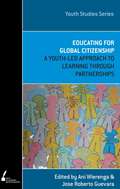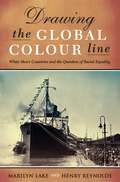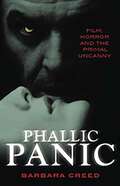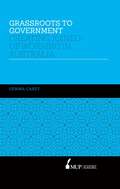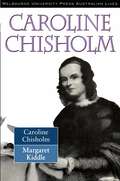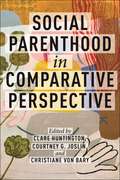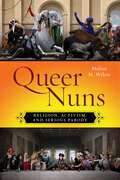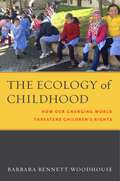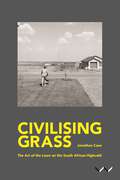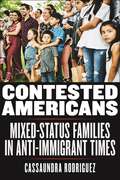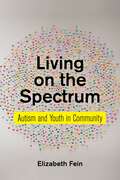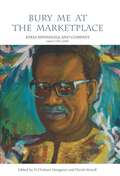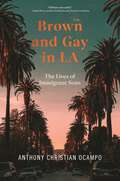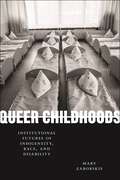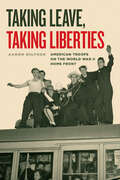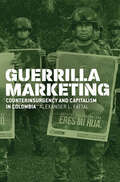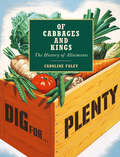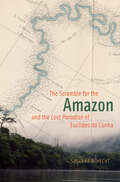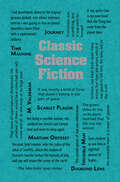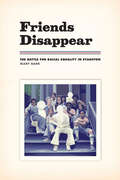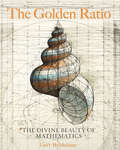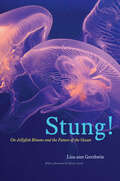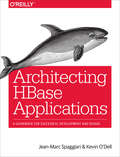- Table View
- List View
Educating for Global Citizenship: A Youth-Led Approach to Learning through Partnerships
by Ani Wierenga Jose Roberto GuevaraThis book explores educating for global citizenship in three parts. The first part identifies the field of global citizenship. The second part identifies a youth-led learning approach to global citizenship. It provides an in-depth and original analysis of the Global Connections program introduced into Australian schools and Indonesian communities over the last decade by Plan International Australia, through a case-study approach. Drawing on data from this project and further analysis, the third part outlines the principles behind learning for global citizenship. Finally, these principles are woven together in a model of inter-agency collaboration between schools, higher education institutions, and non-government agencies. We invite you to explore this fascinating terrain with us. This book is the work of a team. It reflects a long-term partnership between one international NGO, young people, and two universities.
Drawing The Global Colour Line: White Men's Countries and the Question of Racial Equality
by Henry Reynolds Marilyn LakeAt last a history of Australia in its dynamic global context. In the late nineteenth and early twentieth centuries, in response to the mobilisation and mobility of colonial and coloured peoples around the world, self-styled 'white men's countries' in South Africa, North America and Australasia worked in solidarity to exclude those peoples they defined as not-white--including Africans, Chinese, Indians, Japanese and Pacific Islanders. Their policies provoked in turn a long international struggle for racial equality. Through a rich cast of characters that includes Alfred Deakin, WEB Du Bois, Mahatma Gandhi, Lowe Kong Meng, Tokutomi Soho, Jan Smuts and Theodore Roosevelt, leading Australian historians Marilyn Lake and Henry Reynolds tell a gripping story about the circulation of emotions and ideas, books and people in which Australia emerged as a pace-setter in the modern global politics of whiteness. The legacy of the White Australia policy still cases a shadow over relations with the peoples of Africa and Asia, but campaigns for racial equality have created new possibilities for a more just future. Remarkable for the breadth of its research and its engaging narrative, Drawing the Global Colour Line offers a new perspective on the history of human rights and provides compelling and original insight into the international political movements that shaped the twentieth century. Winner of the Ernest Scott Prize 2009 Winner of the Queensland Premier's Prize for History 2009 Winner of the Prime Minister's Prize for Non-Fiction 2009
Phallic Panic
by Barbara CreedVampires, werewolves, cannibals and slashers-why do audiences find monsters in movies so terrifying? In Phallic Panic, Barbara Creed ranges widely across film, literature and myth, throwing new light on this haunted territory. Looking at classic horror films such as Frankenstein, The Shining and Jack the Ripper, Creed provocatively questions the anxieties, fears and the subversive thrills behind some of the most celebrated monsters. This follow-up to her influential book The Monstrous-Feminine is an important and enjoyable read for scholars and students of film, cultural studies, psychoanalysis and the visual arts.
Grassroots to Government: Creating joined-up working in Australia
by Gemma CareyJoined-up government has captured the imaginations of public administrators for many decades. It offers great promise for tackling the complex, or 'wicked', policy problems that concern the governments of industrialised countries. Despite ongoing interest, there remains an absence of core methods and principles to make joined-up government work in practice. Increasingly, public policy scholars are calling for 'evidence-based' joined-up government. However, this evidence is currently in its infancy.In addition to an overview of current debates, Grassroots to Government comprehensively explains the state of evidence in joined-up government, accompanied by an in-depth case study of the experiences of a national joined-up initiative-the Australian Social Inclusion Agenda. In doing so, it offers both a breadth and depth of knowledge on joined-up government. Grassroots to Government is essential reading for anyone interested in designing, implementing and evaluating joined-up and whole-of-government initiatives, including: public service professionals, academics, community sector practitioners, and advanced level students in public policy, social policy and public administration.
Caroline Chisholm
by Margaret Kiddle'The most astonishing thing about her is that she did such work at a time when women were still imprisoned in the strait-jacket of Victorian convention'—Margaret Kiddle Caroline Chisholm was the most remarkable woman in early Australian colonial history. Her national importance has been marked by the use of her portrait on Australian stamps and currency. This is the classic biography of the woman whose remarkable and hard-won achievements first asserted the place of women in Australian public life. Almost single-handedly and against strenuous and sometimes malicious opposition, the indomitable Chisholm worked to establish a Female Immigrants' Home, to encourage family immigration and to fight for better conditions on immigrant ships. Her biography has rightly been acclaimed as outstanding, a landmark in the study of women in Australia's history. The author was herself a pioneer among Australian women historians.
Social Parenthood in Comparative Perspective (Families, Law, and Society #19)
by Clare Huntington Courtney G. Joslin Christiane Von BaryInvestigates social parents – people who function as parents but who may not be recognized as suchin the eyes of the lawWhat makes a person a parent? Around the world, same-sex couples are raising children; parents are separating and re-partnering, creating blended families; and children are living with grandparents, family friends, and other caregivers. In these situations, there is often an adult who acts like a parent but who is unconnected to the child through biogenetics, marriage, or adoption—the common paths for establishing legal parenthood. In many countries, this person is called a “social parent.” Psychologically, and especially from a child’s point of view, a social parent is a parent. But the legal status of a social parent is hotly debated.Social Parenthood in Comparative Perspective considers how the law does—and how it should—recognize social parenthood. The book begins with a psychological account of social parenthood, establishing the importance of a relationship between a child and a social parent and the harms of not protecting this relationship. It then turns to social scientists to identify and explore some circumstances when a child may have a social parent. And to compare legal responses to social parenthood, the book draws on the expertise of legal scholars in nine countries in North America and Europe. The legal contributors describe the existing laws governing social parents, critique their efficacy, and offer new insights. Though almost all of the countries analyzed have adapted to the new reality of family life by recognizing social parents in some manner, the nature and extent of the recognition varies widely.The volume concludes by discussing some of the issues flowing from the decision to recognize social parents, including whether social parents should have the same legal rights and responsibilities as other legal parents, whether all social parents must be treated identically, whether the law should limit a child to two parents, and much more. Families are changing, and the law must adapt accordingly. Social Parenthood in Comparative Perspective charts a way forward by offering solutions to help policymakers consider options for addressing social parenthood.
Queer Nuns: Religion, Activism, and Serious Parody (Sexual Cultures #33)
by Melissa M. WilcoxAn engaging look into the Sisters of Perpetual Indulgence, queer activists devoted to social justice The Sisters of Perpetual Indulgence make up an unlikely order of nuns. Self-described as “twenty-first century queer nuns,” the Sisters began in 1979 when three bored gay men donned retired Roman Catholic nuns’ habits and went for a stroll through San Francisco’s gay Castro district. The stunned and delighted responses they received prompted these already-seasoned activists to consider whether the habits might have some use in social justice work, and within a year they had constituted the new order. Today, with more than 83 houses on four different continents, the Sisters offer health outreach, support, and, at times, protest on behalf of queer communities. In Queer Nuns, Melissa M. Wilcox offers new insights into the role the Sisters play across queer culture and the religious landscape. The Sisters both spoof nuns and argue quite seriously that they are nuns, adopting an innovative approach the author refers to as serious parody. Like any performance, serious parody can either challenge or reinforce existing power dynamics, and it often accomplishes both simultaneously. The book demonstrates that, through the use of this strategy, the Sisters are able to offer an effective, flexible, and noteworthy approach to community-based activism. Serious parody ultimately has broader applications beyond its use by the Sisters. Wilcox argues that serious parody offers potential uses and challenges in the efforts of activist groups to work within communities that are opposed and oppressed by culturally significant traditions and organizations – as is the case with queer communities and the Roman Catholic Church. This book opens the door to a new world of religion and social activism, one which could be adapted to a range of political movements, individual inclinations, and community settings.
The Ecology of Childhood: How Our Changing World Threatens Children’s Rights (Families, Law, and Society #9)
by Barbara Bennett Woodhouse2021 Outstanding Academic Title, Choice MagazineHow globalization is undermining sustainable social environments for children This book uses the ecological model of child development together with ethnographic and comparative studies of two small villages, in Italy and the United States, as its framework for examining the well-being of children in the aftermath of the Great Recession. Global forces, far from being distant and abstract, are revealed as wreaking havoc in children’s environments even in economically advanced countries. Falling birth rates, deteriorating labor conditions, fraying safety nets, rising rates of child poverty, and a surge in racism and populism in Europe and the United States are explored in the petri dish of the village. Globalism’s discontents—unrestrained capitalism and technological change, rising inequality, mass migration, and the juggernaut of climate change—are rapidly destabilizing and degrading the social and physical environments necessary to our collective survival and well-being. This crisis demands a radical restructuring of our macrosystemic value systems. Woodhouse proposes an ecogenerist theory that asks whether our policies and politics foster environments in which children and families can flourish. It proposes, as a benchmark, the family-supportive human-rights principles of the UN Convention on the Rights of the Child. The book closes by highlighting ways in which individuals can engage at the local and regional levels in creating more just and sustainable worlds that are truly fit for children.
Civilising Grass: The art of the lawn on the South African Highveld
by Jonathan CaneCivilising Grass is a socio-cultural analysis of the lawn on the South African highveld, exploring the complex relationship between landscape and power in the country’s colonial, modernist and post-apartheid erasDrawing from eco-criticism, queer theory, art history and postcolonial studies, this book offers a lively and provocative reading of texts and illustrations to reveal the racial and gendered aspects of ‘natural’ environments. It argues that the lawn, an ordinary and often overlooked feature of South African everyday life, is neither natural nor innocent. Rather, like other colonial landscapes, the lawn functions as a site of commonplace violence, of oppression, dispossession and segregation. This book explores an eclectic archive of artistic, literary and architectural lawns between 1886 and 2017, analysing poems, maps, gardening blogs, adverts, ethnographies and ephemera, as well as literature by Koos Prinsloo, Marlene van Niekerk and Ivan Vladislavic. In addition, Civilising Grass includes colour reproductions of lawn artworks by David Goldblatt, Lungiswa Gqunta, Pieter Hugo, Anton Kannemeyer, Sabelo Mlangeni, Moses Tladi and Kemang Wa Lehulere. Examination of these and other works reveals the organic relationship between lawn and wildness, and between lawn and human/non-human actors – thereby providing rich and unexpected insights into South African society past and present.
In Case of Emergency: How Technologies Mediate Crisis and Normalize Inequality
by Elizabeth EllcessorA much-needed look at the growth of emergency media and its impact on our livesIn an emergency, we often look to media: to contact authorities, to get help, to monitor evolving situations, or to reach out to our loved ones. Sometimes we aren’t even aware of an emergency until we are notified by one of the countless alerts, alarms, notifications, sirens, text messages, or phone calls that permeate everyday life. Yet most people have only a partial understanding of how such systems make sense of and act upon an “emergency.” In Case of Emergency argues that emergency media are profoundly cultural artifacts that shape the very definition of “emergency” as an opposite of “normal.” Looking broadly across a range of contemporary emergency-related devices, practices, and services, Elizabeth Ellcessor illuminates the cultural and political underpinnings and socially differential effects of emergency media. By interweaving in-depth interviews with emergency-operation and app-development experts, archival materials, and discursive and technological readings of hardware and infrastructures, Ellcessor demonstrates that emergency media are powerful components of American life that are rarely, if ever, neutral. The normalization of ideologies produced and reinforced by emergency media result in unequal access to emergency services and discriminatory assumptions about who or what is a threat and who deserves care and protection. As emergency media undergo massive growth and transformation in response to digitization and attendant entrepreneurial cultures, Ellcessor asks where access, equity, and accountability fit in all of this. The first book to develop a typology of emergency media, In Case of Emergency opens a much-needed conversation around the larger cultural meanings of “emergency,” and what an ethical and care-based approach to emergency could entail.
Contested Americans: Mixed-Status Families in Anti-Immigrant Times (Latina/o Sociology #9)
by Cassaundra RodriguezHonorable Mention, Distinguished Contribution to Scholarship Book Award, given by the Latino/a Sociology Section of the American Sociological Association2023 C. Wright Mills Award FinalistReveals the impossible choices and downright terror mixed-status families often face for their lovedonesLiving in a mixed-status immigrant family might mean that your grandmother could be deported at any moment, your son could be arrested at work, or your mother’s deportation hearing is postponed—again. Such uncertainty and fear are the reality of life for mixed-status families—those that include both undocumented immigrants and US citizens. In Contested Americans, Cassaundra Rodriguez explores how members of mixed-status families experience and articulate belonging in the United States. The sixteen million people in the US who fall under this classification share the fear of a family member’s possible deportation or the anxiety of leaving behind a child or elderly relative.Rodriguez highlights how different members of the same mixed-status families mediate undocumented statuses while maintaining the collective whole of a family. For many young adults, this may mean negotiating the sponsorship of their immigrant parents, and for the parents, planning for the emotional, physical, and financial well-being of their children in case of deportation.Contested Americans is a timely book, filled with vivid storytelling, that shows how immigration policies, racism, and privilege collide in the backdrop of the lives of millions of mixed-status families.
Living on the Spectrum: Autism and Youth in Community (Anthropologies of American Medicine: Culture, Power, and Practice #8)
by Elizabeth FeinHonorable Mention, 2020 Stirling Prize for Best Published Work in Psychological Anthropology, given by the Society for Psychological AnthropologyHonorable Mention, New Millennium Book Award, given by the Society for Medical AnthropologyHow youth on the autism spectrum negotiate the contested meanings of neurodiversityAutism is a deeply contested condition. To some, it is a devastating invader, harming children and isolating them. To others, it is an asset and a distinctive aspect of an individual’s identity. How do young people on the spectrum make sense of this conflict, in the context of their own developing identity? While most of the research on Asperger’s and related autism conditions has been conducted with individuals or in settings in which people on the spectrum are in the minority, this book draws on two years of ethnographic work in communities that bring people with Asperger’s and related conditions together. It can thus begin to explore a form of autistic culture, through attending to how those on the spectrum make sense of their conditions through shared social practices.Elizabeth Fein brings her many years of experience in both clinical psychology and psychological anthropology to analyze the connection between neuropsychological difference and culture. She argues that current medical models, which espouse a limited definition, are ill equipped to deal with the challenges of discussing autism-related conditions. Consequently, youths on the autism spectrum reach beyond medicine for their stories of difference and disorder, drawing instead on shared mythologies from popular culture and speculative fiction to conceptualize their experience of changing personhood. In moving and persuasive prose, Living on the Spectrum illustrates that young people use these stories to pioneer more inclusive understandings of what makes us who we are.
Bury Me at the Marketplace: Es'kia Mphahlele and Company. Letters 1943-2006
by N Chabani Manganyi and David AttwellWhen Chabani Manganyi published the first edition of selected letters twenty-five years ago as a companion volume to Exiles and Homecomings: A Biography of Es’kia Mphahlele, the idea of Mphahlele’s death was remote and poetic. The title, Bury Me at the Marketplace, suggested that immortality of a kind awaited Mphahlele, in the very coming and going of those who remember him and whose lives he touched. It suggested, too, the energy and magnanimity of Mphahlele, the man, whose personality and intellect as a writer and educator would carve an indelible place for him in South Africa’s public sphere.That death has now come and we mourn it. Manganyi’s words at the time have acquired a new significance: in the symbolic marketplace, he noted, ‘the drama of life continues relentlessly and the silence of death is unmasked for all time’. The silence of death is certainly unmasked in this volume, in its record of Mphahlele’s rich and varied life: his private words, his passions and obsessions, his arguments, his loves, hopes, achievements, and yes, even some of his failures. Here the reader will find many facets of the private man translated back into the marketplace of public memory.Despite the personal nature of the letters, the further horizons of this volume are the contours of South Africa’s literary and cultural history, the international affiliations out of which it has been formed, particularly in the diaspora that connects South Africa to the rest of the African continent and to the black presence in Europe and the United States.This selection of Mphahlele’s own letters has been greatly expanded; it has also been augmented by the addition of letters from Mphahlele’s correspondents, among them such luminaries as Langston Hughes and Nadine Gordimer. It seeks to illustrate the networks that shaped Mphahlele’s personal and intellectual life, the circuits of intimacy, intellectual inquiry, of friendship, scholarship and solidarity that he created and nurtured overthe years. The letters cover the period from November 1943 to April 1987, forty-four of Mphahlele’s mature years and most of his active professional life. The correspondence is supplemented by introductory essays from the two editors, by two interviews conducted with Mphahlele by Manganyi and by Attwell’s insightful explanatory notes.
Brown and Gay in LA: The Lives of Immigrant Sons (Asian American Sociology)
by Anthony Christian OcampoCo-Winner of the 2023 Latino/a Section Best Book Award, given by the American Sociological AssociationHonorable Mention, 2024 Best Book Award, given by the Asia and Asian America section of the American Sociological AssociationThe stories of second-generation immigrant gay men coming of age in Los AngelesGrowing up in the shadow of Hollywood, the gay sons of immigrants featured in Brown and Gay in LA could not have felt further removed from a world where queerness was accepted and celebrated. Instead, the men profiled here maneuver through family and friendship circles where masculinity dominates, gay sexuality is unspoken, and heterosexuality is strictly enforced. For these men, the path to sexual freedom often involves chasing the dreams while resisting the expectations of their immigrant parents—and finding community in each other. Ocampo also details his own story of reconciling his queer Filipino American identity and those of men like him. He shows what it was like for these young men to grow up gay in an immigrant family, to be the one gay person in their school and ethnic community, and to be a person of color in predominantly White gay spaces. Brown and Gay in LA is an homage to second-generation gay men and their radical redefinition of what it means to be gay, to be a man, to be a person of color, and, ultimately, what it means to be an American.
Queer Childhoods: Institutional Futures of Indigeneity, Race, and Disability (Sexual Cultures)
by Mary ZaborskisExplores how the institutional management of children’s sexualities in boarding schools affected children’s future social, political, and economic opportunities Tracing the US’s investment in disciplining minoritarian sexualities since the late nineteenth century, Mary Zaborskis focuses on a ubiquitous but understudied figure: the queer child. Queer Childhoods examines the lived and literary experiences of children who attended reform schools, schools for the blind, African American industrial schools, and Native American boarding schools. In mapping the institutional terrain of queer childhoods in educational settings of the late nineteenth- and twentieth-century, the book offers an original archive of children’s sexual and embodied experiences. Zaborskis argues that these boarding schools—designed to segregate racialized, criminalized, and disabled children from mainstream culture—produced new forms of childhood. These childhoods have secured American futures in which institutionalized children (and the adults they become) have not been considered full-fledged citizens or participants. By locating this queerness in state archives and institutions, Queer Childhoods exposes a queer social history entangled with genocide, eugenics, and racialized violence.
Taking Leave, Taking Liberties: American Troops on the World War II Home Front
by Aaron HiltnerAmerican soldiers overseas during World War II were famously said to be “overpaid, oversexed, and over here.” But the assaults, rapes, and other brutal acts didn’t only happen elsewhere, far away from a home front depicted as safe and unscathed by the “good war.” To the contrary, millions of American and Allied troops regularly poured into ports like New York and Los Angeles while on leave. Euphemistically called “friendly invasions,” these crowds of men then forced civilians to contend with the same kinds of crime and sexual assault unfolding in places like Britain, France, and Australia. With unsettling clarity, Aaron Hiltner reveals what American troops really did on the home front. While GIs are imagined to have spent much of the war in Europe or the Pacific, before the run-up to D-Day in the spring of 1944 as many as 75% of soldiers were stationed in US port cities, including more than three million who moved through New York City. In these cities, largely uncontrolled soldiers sought and found alcohol and sex, and the civilians living there—women in particular—were not safe from the violence fomented by these de facto occupying armies. Troops brought their pocketbooks and demand for “dangerous fun” to both red-light districts and city centers, creating a new geography of vice that challenged local police, politicians, and civilians. Military authorities, focused above all else on the war effort, invoked written and unwritten legal codes to grant troops near immunity to civil policing and prosecution. The dangerous reality of life on the home front was well known at the time—even if it has subsequently been buried beneath nostalgia for the “greatest generation.” Drawing on previously unseen military archival records, Hiltner recovers a mostly forgotten chapter of World War II history, demonstrating that the war’s ill effects were felt all over—including by those supposedly safe back home.
Guerrilla Marketing: Counterinsurgency and Capitalism in Colombia (Chicago Studies in Practices of Meaning)
by Alexander L. FattalBrand warfare is real. Guerrilla Marketing details the Colombian government’s efforts to transform Marxist guerrilla fighters in the FARC into consumer citizens. Alexander L. Fattal shows how the market has become one of the principal grounds on which counterinsurgency warfare is waged and postconflict futures are imagined in Colombia. This layered case study illuminates a larger phenomenon: the convergence of marketing and militarism in the twenty-first century. Taking a global view of information warfare, Guerrilla Marketing combines archival research and extensive fieldwork not just with the Colombian Ministry of Defense and former rebel communities, but also with political exiles in Sweden and peace negotiators in Havana. Throughout, Fattal deftly intertwines insights into the modern surveillance state, peace and conflict studies, and humanitarian interventions, on one hand, with critical engagements with marketing, consumer culture, and late capitalism on the other. The result is a powerful analysis of the intersection of conflict and consumerism in a world where governance is increasingly structured by brand ideology and wars sold as humanitarian interventions. Full of rich, unforgettable ethnographic stories, Guerrilla Marketing is a stunning and troubling analysis of the mediation of global conflict.
Of Cabbages and Kings: The History of Allotments
by Caroline Foley“An excellent account” of Britain’s tradition of parceling out land for the public to grow food on, and the colorful history behind it (The Independent).This lively book tells the story of the private garden plots known as allotments—from their origin in the seventeenth century, when new enclosures that deprived the peasantry of access to common lands were fiercely protested, to the victory gardens of the world wars, and into the present day, when they serve less as a means of survival than as a respite from the modern world. While delving into the effects of the Napoleonic Wars, the Corn Laws, and the utopian dissenters known as the Diggers, the author reveals the multiple roles of allotments—and champions their history in the hope of protecting them for the future. “Foley’s book reminds us that the right to share the earth has always been an asymmetric struggle.” —The Guardian“Fascinating and handsomely illustrated.” —Daily Mail“Well-told . . . . [a] gallop through the history of useful rather than ornamental crops.” —Spectator Australia
The Scramble for the Amazon and the Lost Paradise of Euclides da Cunha
by Susanna B. HechtA “compelling and elegantly written” history of the fight for the Amazon basin and the work of a brilliant but overlooked Brazilian intellectual (Times Literary Supplement, UK).The fortunes of the late nineteenth century’s imperial powers depended on a single raw material—rubber—with only one source: the Amazon basin. This scenario ignited a decades-long conflict that found Britain, France, Belgium, and the United States fighting with and against the new nations of Peru, Bolivia, and Brazil for the forest’s riches. In the midst of this struggle, the Brazilian author and geographer Euclides da Cunha led a survey expedition to the farthest reaches of the river. The Scramble for the Amazon tells the story of da Cunha’s terrifying journey, the unfinished novel born from it, and the global strife that formed the backdrop for both. Haunted by his broken marriage, da Cunha trekked through a beautiful region thrown into chaos by guerrilla warfare, starving migrants, and native slavery. All the while, he worked on his masterpiece, a nationalist synthesis of geography, philosophy, biology, and journalism entitled Lost Paradise. Hoping to unveil the Amazon’s explorers, spies, natives, and brutal geopolitics, Da Cunha was killed by his wife’s lover before he could complete his epic work. once the biography of Da Cunha, a translation of his unfinished work, and a chronicle of the social, political, and environmental history of the Amazon, The Scramble for the Amazon is a work of thrilling intellectual ambition.
Classic Science Fiction (Word Cloud Classics)
by Editors of Canterbury ClassicsNine classic works of speculative fiction from the earliest masters of the genre.Classic Science Fiction includes nine stories from masters of early science fiction: H. G. Wells, Jules Verne, H. P. Lovecraft, Edgar Allan Poe, Jack London, Fitz James O&’Brien, Charlotte Perkins Gilman, and Stanley G. Weinbaum. The exploration of new concepts and technologies has driven the genre since its earliest days, and these works demonstrate how science fiction evolved to encompass not only speculative science but also humanity&’s role in the universe.
Friends Disappear: The Battle for Racial Equality in Evanston
by Mary BarrA sociologist returns to her suburban Illinois hometown to compare the paths of black and white childhood friends in a “fascinating” mix of study and memoir (Chicago Tribune).Mary Barr thinks a lot about the old photograph on her refrigerator door. In it, she and a dozen or so friends from the Chicago suburb of Evanston sit on a porch. It’s 1974, the summer after they graduated from Nichols Middle School, and what strikes her immediately—aside from the Soul Train–era clothes—is the diversity of the group: boys and girls, black and white, in the variety of poses you’d expect from a bunch of friends on the verge of high school. But the photo also speaks to the history of Evanston, to integration, and to the ways that those in the picture experienced and remembered growing up in a place that many at that time considered to be a racial utopia.In Friends Disappear, Barr goes back to her old neighborhood and pieces together a history of Evanston with a particular emphasis on its neighborhoods, its schools, and its work life. She finds that there is a detrimental myth of integration surrounding Evanston despite bountiful evidence of actual segregation, both in the archives and from the life stories of her subjects. Curiously, the city’s own desegregation plan is partly to blame. The initiative called for the redistribution of students from an all-black elementary school to institutions situated in white neighborhoods. That, however, required busing, and between the tensions it generated and obvious markers of class difference, the racial divide, far from being closed, was widened. Friends Disappear highlights how racial divides limited the life chances of blacks while providing opportunities for whites, and offers an insider’s perspective on the social practices that doled out benefits and penalties based on race—despite attempts to integrate.“Barr’s gripping exploration of the divergent paths friends took away from a childhood snapshot combines the rigor of scholarship with the personal touch of memoir. I have rarely read a book that so effectively illustrates the persistence of racial disparities in the United States with unforgettable, wrenching life stories.” —Amanda Seligman, University of Wisconsin-MilwaukeeHonorable Mention, Midwest Sociological Society Distinguished Book Award
The Golden Ratio: The Divine Beauty of Mathematics
by Gary B. MeisnerThis enlightening and gorgeously illustrated book explores the beauty and mystery of the divine proportion in art, architecture, nature, and beyond.From the pyramids of Giza, to quasicrystals, to the proportions of the human face, the golden ratio has an infinite capacity to generate shapes with exquisite properties. Author Gary Meisner has spent decades researching the subject, investigating and collaborating with people across the globe in dozens of professions and walks of life. In The Golden Ratio, he shares his enlightening journey. Exploring the long history of this fascinating number, as well as new insights into its power and potential applications, The Golden Ratio invites you to take a new look at this timeless topic.
The Art of Drawing People: Discover Simple Techniques for Drawing a Variety of Figures and Portraits
by Walter Foster Creative TeamLearn to draw faces, features, and figures in graphite, with inspiration from four accomplished artists.Packed with practical advice, helpful tips, and fundamental techniques, this comprehensive book is an essential resource to which artists of all skill levels will refer again and again. The Art of Drawing People comprises instruction from a group of four experienced artists who demonstrate the processes of drawing the human head and clothed figure from infancy through old age in a variety of poses.The talented authors also share their knowledge about underlying anatomy, ethnic influences, and natural variations in shape, texture, and proportion, as well as basic information about drawing tools and pencil techniques.
Stung!: On Jellyfish Blooms and the Future of the Ocean
by Lisa-ann Gershwin“The world of jellyfish is brought alive as you never imagined it could be by Lisa-ann Gershwin in this engaging, gripping, and often funny book.” —Callum Roberts, author of The Ocean of LifeAs our oceans become increasingly inhospitable to life, there is one creature that is thriving in this seasick environment: the beautiful, dangerous, and now incredibly numerous jellyfish. As foremost jellyfish expert Lisa-ann Gershwin describes in Stung!, the jellyfish population bloom is highly indicative of the tragic state of the world’s ocean waters, while also revealing the incredible tenacity of these remarkable creatures.Despite their often dazzling appearance, jellyfish are simple creatures with simple needs: namely, fewer predators and competitors, warmer waters to encourage rapid growth, and more places for their larvae to settle and grow. In general, oceans that are less favorable to fish are more favorable to jellyfish, and these are the very conditions that we are creating through mechanized trawling, habitat degradation, coastal construction, pollution, and climate change.Despite their role as harbingers of marine destruction, jellyfish are truly enthralling creatures in their own right, and in Stung!, Gershwin tells stories of jellyfish both attractive and deadly while illuminating many interesting and unusual facts about their behaviors and environmental adaptations. She takes readers back to the Proterozoic era, when jellyfish were the top predator in the marine ecosystem—at a time when there were no fish, no mammals, and no turtles; and she explores the role jellies have as middlemen of destruction, moving swiftly into vulnerable ecosystems. The story of the jellyfish, as Gershwin makes clear, is also the story of the world’s oceans, and Stung! provides a unique and urgent look at their inseparable histories—and future.
Architecting HBase Applications: A Guidebook for Successful Development and Design
by Kevin O'Dell Jean-Marc SpaggiariHBase is a remarkable tool for indexing mass volumes of data, but getting started with this distributed database and its ecosystem can be daunting. With this hands-on guide, you’ll learn how to architect, design, and deploy your own HBase applications by examining real-world solutions. Along with HBase principles and cluster deployment guidelines, this book includes in-depth case studies that demonstrate how large companies solved specific use cases with HBase.Authors Jean-Marc Spaggiari and Kevin O’Dell also provide draft solutions and code examples to help you implement your own versions of those use cases, from master data management (MDM) and document storage to near real-time event processing. You’ll also learn troubleshooting techniques to help you avoid common deployment mistakes.Learn exactly what HBase does, what its ecosystem includes, and how to set up your environmentExplore how real-world HBase instances were deployed and put into productionExamine documented use cases for tracking healthcare claims, digital advertising, data management, and product qualityUnderstand how HBase works with tools and techniques such as Spark, Kafka, MapReduce, and the Java APILearn how to identify the causes and understand the consequences of the most common HBase issues
